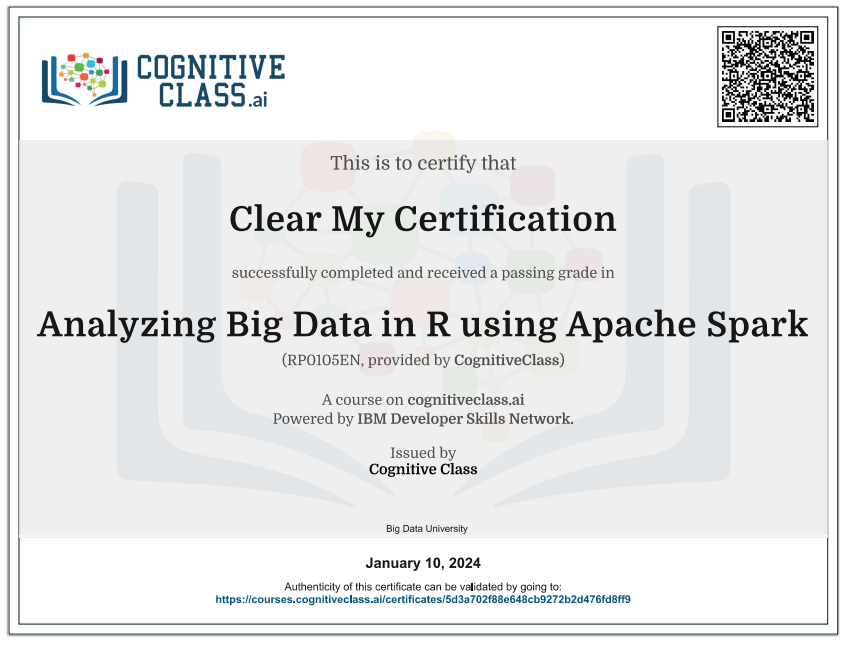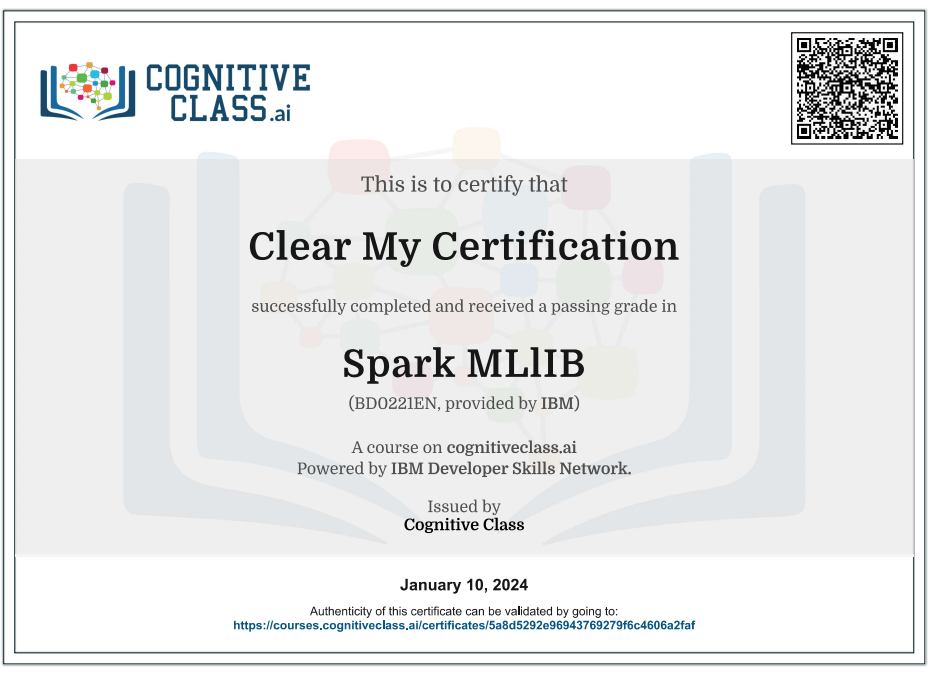Enroll Here: Controlling Hadoop Jobs using Oozie Cognitive Class Exam Quiz Answers
Controlling Hadoop Jobs using Oozie Cognitive Class Certification Answers

Module 1 – Introduction of Oozie Workflows Quiz Answers – Cognitive Class
Question 1: Oozie definitions written in the Hadoop Process Definition Language (hPDL) are encoded in which of the following files?
- workflow.txt
- workflow.html
- workflow.json
- workflow.xml
Question 2: Oozie detects job completion via callback and polling. True or false?
- False
- True
Question 3: The Oozie expression language (EL) provides access to all of the following except
- error codes
- workflow job size
- application name
- workflow job id
Module 2 – Oozie Coodinator Quiz Answers – Cognitive Class
Question 1: Which of the following can trigger the start of an Oozie job?
- The Oozie CLI
- Data
- An application call to the API
- Time
- All of the above
Question 2: The Oozie coordinator works with Central European Time (CET). True or false?
- False
- True
Question 3: The Coordinator Job uses all of the following files except
- job.properties
- coord-config-default.xml
- coordinator.properties
- coordinator.xml
Module 3 – BigInsights Workflow Editor Quiz Answers – Cognitive Class
Question 1: Which of the following statements about the BigInsights Workflow Editor is correct?
- It displays a read-only diagram to show the overall workflow
- It runs in an Eclipse environment
- It supports complex Oozie workflows without requiring knowledge of the Oozie xml xds schema
- It’s a new feature, and it was introduced to BigInsights in version 2.0
- All of the above
Question 2: You can use the BigInsights Workflow Publishing Wizard as a graphical tool to create and modify a workflow.xml file. True or false?
- False
- True
Question 3: Which of the following statements is NOT correct?
- The InfoSphere BigInsights Tool for Eclipse is essentially an Eclipse module with BigInsights add-ins.
- At a higher level, we can link multiple applications to run in sequence.
- We cannot build sub-workflows in a workflow.
- Deployed applications can be scheduled.
Controlling Hadoop Jobs using Oozie Final Exam Answers – Cognitive Class
Question 1: What is the primary purpose of Oozie in the Hadoop architecture?
- To provide logging support for Hadoop jobs
- To support the execution of workflows consisting of a collection of actions
- To support SQL access to relational data stored in Hadoop
- To move data into HDFS
Question 2: How are Oozie workflows defined?
- Using the Java programming language
- Using JSON
- Using a plain text file that defines the graph elements
- Using hPDL
Question 3: Control nodes in an Oozie Workflow can contain all of the following except
- Start
- Fork
- Pig
- End
- Kill
Question 4: A workflow job can be executed from
- A Java API
- A Web-server API
- The command line
- All of the Above
Question 5: Where do the workflow.xml, config-default.xml, JAR, and .so files need to be stored prior to Oozie workflow job execution?
- On a web-server
- In HDFS within a defined directory structure
- On the local file system where you are executing the job
- None of the above
Question 6: What is the purpose of the Oozie Coordinator?
- To invoke workflows when some external event occurs
- To invoke workflows when data becomes available
- To invoke workflows at regular intervals
- All of the above
Question 7: Which of the following need to be stored in HDFS?
- coordinator.xml only
- coord-config-default.xml only
- coordinator.properties only
- coordinator.xml and coord-config-default.xml only
- coordinator.xml and coordinator.properties only
Question 8: The Oozie coordinator can be executed from
- A Java API
- A Web-server API
- The command line
- All of the Above
Question 9: How is an Oozie coordinator configured?
- Using the Java programming language
- Using JSON
- Using a plain text file that defines the workflow schedule
- Using XML
Question 10: By defining a dataset template as part of the coordinator.xml file, you can use the coordinator to trigger a workflow when an updated dataset has arrived in HDFS. True or false?
- True
- False
Question 11: coordinator.properties can be used to establish
- values for variables used in workflow.xml
- values for variables used in coordinator.xml
- the location of the coordinator job in HDFS
- All of the above
Question 12: job.properties can be used to establish
- The location of the workflow job in HDFS, only
- Values for variables used in workflow.xml, only
- The actions to perform at each stage of the workflow, only
- Values for variables used in workflow.xml, and the actions to perform at each stage of the workflow
- The location of the workflow job in HDFS, and values for variables used in workflow.xml
Question 13: The kill node is used to indicate a successful completion of the Oozie workflow. True or false?
- True
- False
Question 14: The join node in an Oozie workflow will wait until all forked paths have completed. True or false?
- True
- False
Question 15: Decision nodes can be used to select from multiple alternative paths through an Oozie workflow. True or false?
- True
- False
Introduction to Controlling Hadoop Jobs using Oozie
Apache Oozie is a workflow scheduler system designed to manage and control Hadoop jobs. It enables the creation and execution of complex data workflows, coordinating various Hadoop ecosystem components such as MapReduce, Hive, Pig, and more. Here are the key steps to control Hadoop jobs using Oozie:
1. Installation and Configuration:
- Install Apache Oozie on your Hadoop cluster. Ensure that Oozie is configured properly to connect to your Hadoop ecosystem.
2. Workflow Definition:
- Define your workflow using Oozie’s XML-based workflow definition language. A workflow in Oozie is a directed acyclic graph (DAG) of actions.
- Actions can be Hadoop MapReduce jobs, Hive queries, Pig scripts, or other types of tasks.
3. Create Workflow XML:
- Write an XML file that describes your workflow. This file typically includes information such as which jobs to run, in what order, and what data dependencies exist between them.
4. Upload Workflow to HDFS:
- Upload the workflow XML file to HDFS (Hadoop Distributed File System) so that Oozie can access it.
5. Submit Workflow to Oozie:
- Use the Oozie command-line interface or REST API to submit your workflow to Oozie for execution. Oozie will parse the workflow, validate it, and schedule the jobs based on the defined dependencies.
6. Coordinator for Periodic Jobs:
- Oozie provides coordinators for managing periodic workflows. If your Hadoop jobs need to be scheduled at specific intervals, use coordinators to define the schedule and frequency of job execution.
7. Monitoring and Logging:
- Oozie provides a web-based user interface where you can monitor the progress of your workflows. You can check job status, logs, and other relevant information.
8. Error Handling:
- Implement error handling in your Oozie workflow. Oozie allows you to specify actions for success or failure of tasks, helping you define how the workflow should proceed in case of errors.
9. Parameterization:
- Parameterize your workflows to make them more flexible and reusable. You can use parameters in your workflow definition to customize job configurations or input/output paths.
10. Integration with Hadoop Ecosystem:
- Integrate Oozie with various Hadoop ecosystem components such as Hive, Pig, MapReduce, and others. Specify the actions in your workflow that execute these components.
11. Security Considerations:
- Ensure that Oozie and Hadoop are configured with proper security settings. This may involve setting up authentication, authorization, and securing communication channels.
12. Workflow Optimization:
- Optimize your workflows for performance. This may involve tuning Hadoop job configurations, adjusting resource allocations, and designing efficient data workflows.
13. Scaling:
- Consider scaling your workflows based on your cluster size and workload. Oozie can handle the coordination of large-scale workflows across a distributed environment.
14. Versioning:
- Consider versioning your workflows, especially in environments where workflows may evolve over time. This helps in maintaining and updating workflows without disrupting ongoing operations.
By following these steps, you can effectively control and manage Hadoop jobs using Apache Oozie. Oozie’s workflow management capabilities simplify the coordination of complex data processing tasks in a Hadoop environment.
 Clear My Certification All Certification Exam Answers
Clear My Certification All Certification Exam Answers



